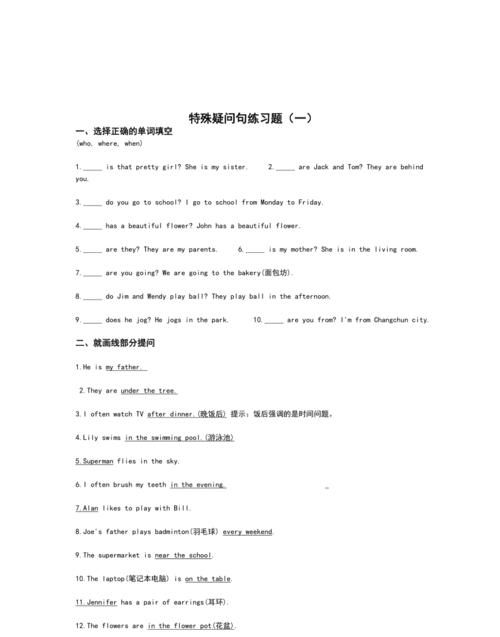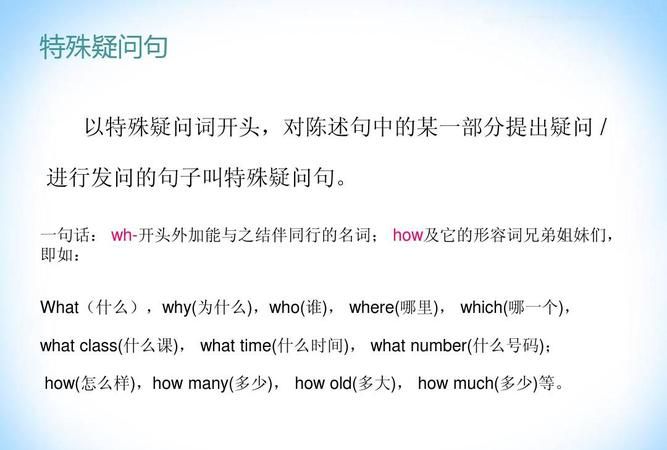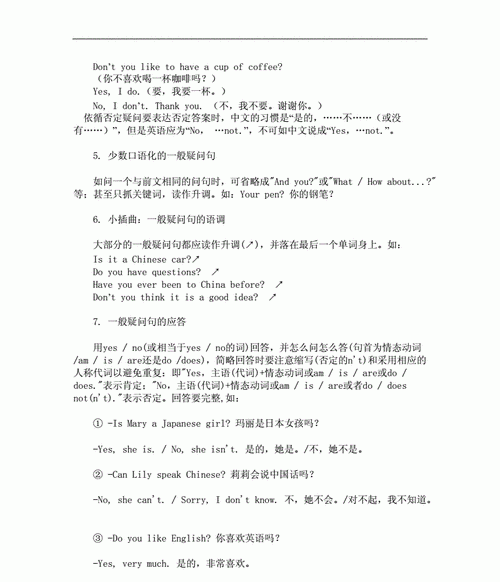本文目录
英语的一般疑问句是什么开头
主语一般是名词比如(a
dog,
a
cat,
he,
she,
Wang
Lin,
Linda....).
be是be动词,比如is,
am
,are
,was,were...
一般疑问句就是把be动词或者助动词提到主语的前面,比如
She
is
a
girl.她是个女孩。(主语是she,be动词是is)
Is
she
a
girl?她是个女孩吗?(be动词is提到了主语she的前面)

英语一般疑问句的结构
疑问句是问一些事情的,可分为:
和
一、
也可称为 “yes / no questions”,因这种问句通常用yes / no来回答,相当于汉语中的“……吗?”其语序是:
be /
/
+主语+其他成分?如:
Are you from Japan?
Yes I am. / No I'm not.
Is her
doing her homework now?
Yes she is. / No she isn't.
Does he work in a bank?
Yes he does. / No he doesn't.
Do you live near your school?
Yes I do. / No I don't.
Can you speak French?
Yes I can. / No I can't.
May I go home now?
Yes you may. / No you mustn't.
注意:
1.将
变为一般疑问句时,如句中有be 动词(am is are …)时,可直接将它们提至主语前.如主语为第一人称,应将其改为
.如:
I'm in Class 2Grade 1. →
Are you in Class 2Grade
We're watching TV. →
Are you watching TV?
2.
中有
(can may must …)时,也可直接将它们提至主语前,即可成为一般疑问句.如:
He can swim now. →
Can he swim now?
The children may come with us. → May the children come with us?
3.
中只有一个
作谓语且其时态为
,变为一般疑问句时要在句首加do或does 主语后的
用原形.如:
I like these animals. →
Do you like these animals?
She wants to go to the movies. → Does she want to go to the movies?
4.一般疑问句一般读升调(↑)
5.一般疑问句有时不用yes或 no 回答.如:
Are they in town now?
I think so.

一般疑问句和特殊疑问句的区别
General
Questions(一般疑问句)
一般疑问:用be或助动词置于句首,并以“Yes,…”,或“No,…”回答的问句称为一般疑问(也称Yes-no
questions)。
Special
Questions
(特殊疑问句)
特殊疑问(Wh-questions):使用疑问词(what,who,which,how,why,when,where,etc.)发问,不能用“Yes,…”或“No,…”回答的问句叫做特殊疑问句(也称Wh-questions)。

英语一般疑问句怎么写
一、什么是一般疑问句?
一般说来,英语中共有四种问句,分别是一般疑问句、特殊疑问句、选择疑问句和反意义疑问句。今天我们来学习一般疑问句。那么,什么是一般疑问句呢?我们一起来听听一般疑问句的自白:
“Hello, 大家好!我是一般疑问句,我的天性是爱发问。我最爱做的事是询问某种情况是否属实,您不对我做出肯定或否定回答我是不会罢休的。您也可用肢体语言来打发我,比如点头或则摇头。所以我有一对好朋友,猜猜是什么?对了,YES 和 NO!”
二、一般疑问句的结构
一般疑问句有两个家族。
第一家族为含be动词或情态动词的一般疑问句,其结构为:
be + 主语 + 其它部分?
情态动词 + 主语 + 动词原形 + 其它部分?
肯定回答用“Yes,主语+be\情态动词.”,否定回答用“No,主语+be\情态动词+not.”。be或情态动词和not可用缩写形式,主要有isn’t,aren’t,wasn’t,weren’t,can’t,mustn’t,needn’t等。
Eg1. 问句: Is this your English book?
肯答: Yes,it is.
否答: No,it isn`t.
Eg2. 问句: Are these your English books?
肯答: Yes,they are.
否答: No,they aren’t.
Eg3. 问句: Can you speak English?
肯答: Yes,I can.
否答: No,I can’t.
注意例句1和例句2,在回答时必须将this\that与these\those分别变为it和they。
另一家族为含行为动词(或称为实义动词)的一般疑问句,其结构为:
助动词 + 主语 + 动词原形 + 其它?
肯定回答用“Yes, 主语+ do\does.”,否定回答用“No, 主语+don\does not.”。助动词也常用缩写形式,主要有don’t,doesn’t,didn’t等。
Eg4. 问句: Do your parents like English?
肯答: Yes,they do.
否答: No,they don’t.
三、一般疑问句的回答
正如前面所述,回答一般疑问句时有肯定回答和否定回答两种方式,肯定回答以Yes起句,否定回答用No开头。但对一般疑问句的回答也不是一成不变的。肯定回答还可以用OK./Certainly.等;否定回答可用Sorry./Sorry,I can`t.等。
Eg5. 问句: Can you speak English?
肯答: Certainly \ Of course.
否答: Sorry, I can’t.
四、一般疑问句的语调
朗读一般疑问句时用升调,而一般疑问句的简略答语则用降调。
五、如何将陈述句变为一般疑问句?
根据一般疑问句不同的家族,可以用不同的方法将陈述句变为相应的一般疑问句。
1、第一家族:含be动词或情态动词的句子
秘诀:一调二改三问号
一调:即把句中的be或情态动词调到主语前;
二改:改换主语称谓,即将句中的主语I\my \mines\we\our\ours等第一人称分别改为相应的第二人称you\your\ yours等;
三问号:句末的句号改为问号。如:
Eg6. I am an English teacher. → Are you an English teacher?
Eg7. We can speak English fluently. → Can you speak English fluently?
2、第二家族:含行为动词(或称为实义动词)的句子
秘诀:一加二改三问号
一加:即在句首加助动词Do或Does;
二改:1、把谓语动词改为原形;2、改换主语称谓(同第一家组);
三问号:句末的句号改为问号。
Eg8. We read English every morning. → Do you read English every morning?
Eg9. Tom’s father listens to English on the radio every evening. →
Does Tom’s father listen to English on the radio every evening?
特别注意:对于第二家族一定要注意动词的还原,因为时态与数的变化已经体现在助动词上了。
3、 加强记忆口诀:
“肯变一,并不难,can 或be提在前;
谓语若为行为动,do 或does句首用。”
六、“some”还是“any”?
在一般疑问句中,要表达“一些”时 ,一般用any,但如果这个问句是用来表达 “建议、请求、邀请”等交际功能时 ,应该用some.
Eg10. Is there any tea in the cup?
Eg11. Do you have any children?
Eg12. May I have some fish?
Eg13. Would you like some tea?
Eg14. Shall we buy some vegetables?
Eg15. Can I borrow some money from you?
Eg16. Why not have some bread?
Eg17. How about some orange juice?

以上就是关于一般疑问句英语表达 ,英语的一般疑问句是什么开头的全部内容,以及一般疑问句英语表达 的相关内容,希望能够帮到您。
